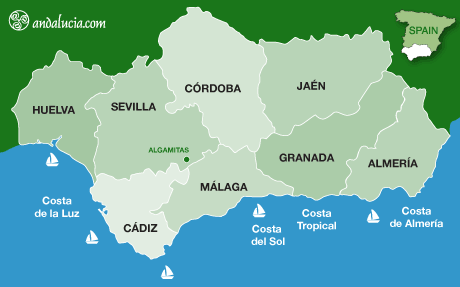ALGÁMITAS
by Saskia Mier
Algámitas is home to the large rock known as, El Peñón, which sits opposite to the highest point of Seville, Pico del Terril, and Sierra de Tablone. It has about 1, 200 inhabitants.
HISTORY
The origin of Algámitas is suggested to have come from a settlement called Callet, which dispersed from what is now the town of Pruna, to near the Corbones River. Archaeological remains have been found dating from the Phoenician period and it is known that during the Moorish period, the village was named Hagalmi and later passing into the hands of the Greeks. During Roman dominion, according to historian Hirtio, it was called Silicens. During this reign, there were other human settlements in the area of Algámitas, such as Diente de la Vieja.
During the Moorish era, Algámitas was an agricultural and livestock farm. Some Moroccan Arabs, descendants of the exiles in the "re-conquest" believe that Algámitas had mountains, known as the Membrilla, in which there was more gold than in the sands. It is suggested that the gold refers to the wealth and abundance of water and the quality of its climate and lands.
The Moors called the settlement, Algameca. After the "re-conquest", this territory passed to the Lordship of Pruna, granted by King Enrique IV to the Knight, Don Rodrigo de Rivera, being later sold by his son, Don Pedro de Rivera, to the Count of Arcos, Don Rodrigo Ponce de León, in 1482. It belonged to this noble house until the suppression of jurisdictional lordships in the nineteenth century. Isabel II granted Algámitas the title of town in 1852.
THINGS TO SEE
Iglesia del Dulce Nombre de Jesús
The church current construction of the church is modern as well as the images conserved in its interior, dating to the twentieth century. Located in Plaza Iglesia.
NATURAL AREAS
El Peñón
El Peñón is a large rock whose summit reaches an altitude of 1,121m. On one of its slopes, 800m high, is the Rural Complex "El Peñón", consisting of 50ha of oak forest. In addition, you can visit the Natural Park of the Sierra de Grazalema and the Natural Reserve of "Peñón de Zaframagón" with one of the most important buitreras (gathering of vultures) of Andalusia. Located on the SE-462.
El Terril
With 1,129m in height, El Terril is the highest peak in the province of Seville, flanked by the summits of El Peñón de Algámitas (1121 m) and Puerto del Zamorano (777 m). Located between the towns of Pruna and Algámitas, in the middle of the Sevillian Sierra Sur, on Calle Sierra y Arroyo de Ballesteros.
Puerto del Zamorano
Located in the Sierra Sur, specifically in the Sierra del Tablón, this natural mountain pass separates El Terril from El Peñón de Algámitas. It is crossed by the SE-462 road that connects the towns of Pruna and Algámitas and has an altitude of 777m.
Sierra del Tablón
A huge calcareous block of rugged terrain with different levels of between 30% and 50%. It is the highest point in the province of Seville, where the average temperature is 17.3°C and the average annual rainfall is 890mm. The Sierra del Tablón, in addition to El Terril, includes El Peñón de Algámitas, Puerto del Zamorano and Sierra de Las Lebronas.
Hotels near Algámitas
Book Hotels near Algámitas
GASTRONOMY
Traditional dishes to try in Algámitas consist of cocido de berza (chickpea, chard and meat stew), trancos de acelgas, judías blancas y garbanzos (chard with white beans and chickpeas), jarrete (stewed hock), carne en salsa (meat in sauce), gazpacho and migas (fried bread with chorizo). Game meat such as liebre (hare), perdiz (partridge), conejo (rabbit), codorniz (quail) and tortola (dove) are also very popular. One must definitely try the local porra algamiteña.
Festivals
Cabalgata Reyes Magos
Three Kings procession celebrated on the evening of 5 January.
Fiesta del Dulce Nombre
Celebrated the third Sunday of January.
Carnaval
Celebrated in February.
Semana Santa
Holy Week.
Fiesta del Huerto
Celebrated on Resurrection Sunday.
Romería de San Isidro Labrador
Celebrated the middle of May.
Feria de Santiago
Celebrated at the end of July.
NEXT PLACES
The next villages to Algámitas are Pruna, Villanueva de San Juan and El Saucejo.


